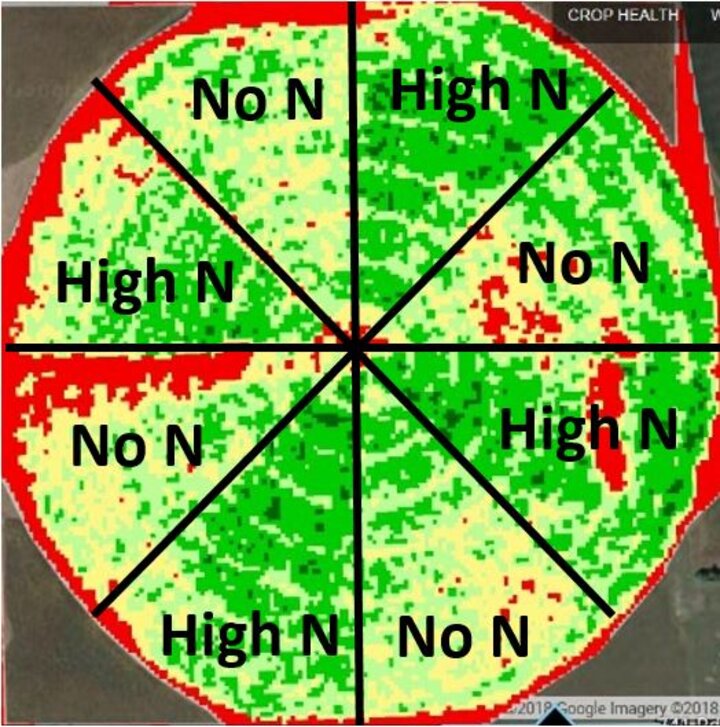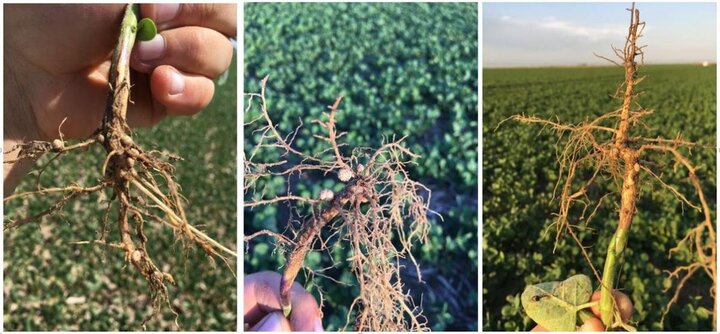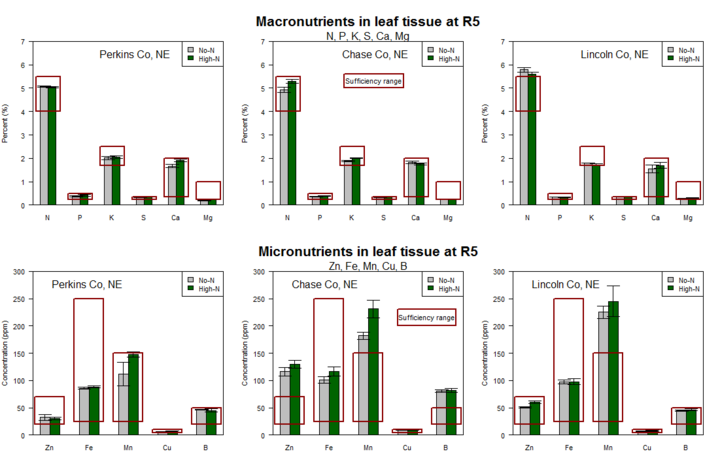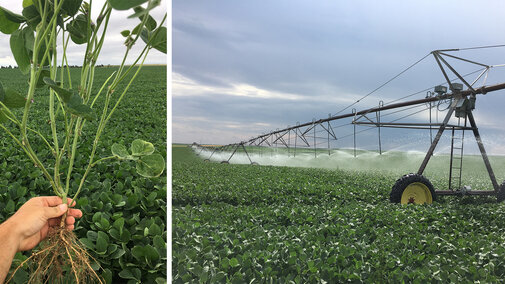Soybean absorbs 60% of total N uptake during the pod setting and seed filling phases. Is N supplied from soil N and biological fixation sufficient to meet this demand, or do soybeans need supplemental N to reach their full yield potential?
On-Farm Research Trials in Southwest Nebraska
To answer farmer questions as to whether the practice of late-season N application increases yield and enhances profit in western Nebraska soybeans, we conducted on-farm research studies in three southwest counties (Perkins, Chase and Lincoln) in 2017.


The plot layout consisted of alternating pie-shaped sections over an entire pivot. Some segments received N through the pivot and some were left as untreated checks (Figure 1). A foliar application of 65-85 lb/acre of N was made through an irrigation application at the R3 (beginning pod) growth stage.

Surface (0-8 inch depth) and sub-surface (8-24 inch depth) soil samples were collected in each pie at three times: prior to planting, at the R2 growth stage, and after harvest. This was to identify changes in both NO3-N and NH4-N soil concentrations throughout the growing season (Figure 2). Visual nodulation inspection was conducted at V7 growth stage (Figure 3) and plant tissue samples were taken at the R2 and R5-R6 growth stages to monitor nutrient content within the plants (Figures 4 and 5). Plant residue was analyzed for residual N content (Table 1, below). In addition to yield, grain samples were analyzed for protein and oil content (Table 1).
Main Findings
- Soybean plants at Perkins County and Lincoln County had many active nodules well spread on the roots. Nodulation at Chase County was very poor, possibly due to excessive mineral N in the top 24 inches of soil (Figure 3). The amount of soil N available at planting (62-106 lbs/ac) had decreased by more than 50% when measured at the R2 growth stage (30-40 lbs/ac), suggesting that the plant was taking up soil N as it entered the reproductive stages.
- Nutrient concentrations of both micro- and macronutrients in plant tissue did not differ between the N treatments (Figures 4-5). The nutrient levels in plant tissue at all three sites were within the sufficiency range for all macronutrients and micronutrients, except for magnesium (Mg). A positive correlation was found between N supplementation and manganese (Mn) uptake and metabolism.
- Supplementing N to soybeans at R3 did not increase yield, grain protein, oil content, or marginal net return at any of the three locations (Table 1). A slight yield increase of 2.6 bu/ac was observed at Perkins County, but due to large field variability this increase cannot be attributed to additional N fertilizer. The post-harvest soil N was similar in both N treatments. The only notable difference in end-of-season N balance was N content in plant residue, which was 5, 8, and 14 lbs of N/ac higher in the N treatments at Chase County, Lincoln County, and Perkins County, respectively.


Take-Home Message
More Research on N in Soybean
The article, “Is Soybean Yield Limited by Nitrogen Supply,” reports on field experiments in eastern Nebraska and Argentina. The authors’ findings indicate soybean yield was limited by N supply, especially in high-yield environments, and that N supplementation slightly increased yield and seed protein content. See the full research report in Field Crops Research.
An article from retired University of Nebraska-Lincoln Soil Scientist Charles Shapiro titled “Nitrogen on Soybeans – the Hope Never Dies” looks at two recent research studies and searches for the answer to the lack of response by soybeans to N in cases when N balance (supply vs. demand) clearly suggests that supplementation is needed. The papers being compared both suggest "that in high-yielding environments, nitrogen is likely to have a marginal beneficial effect." Shapiro points to the need for future research on N timing, application, source, and management for high-yielding soybeans.
- Late season (R3) N fertilization did not increase yield or profit of soybeans grown at three on-farm trials in southwest Nebraska in 2017. Supplementing N to soybeans is more likely to be beneficial in higher yielding environments, perhaps higher than yields achieved in these studies (up to 77 bu/ac).
- More research is needed to fine-tune soybean fertility management. Based on our findings, we suggest further work relative to:
- spoon-feeding lighter rates of N to soybean during the reproductive stages (rather than applying one large amount at one time),
- applying lower rates of N later in the season (R5-R6 growth stages),
- using manure or compost as a form of slow release N,
- consideration of foliar micro- and macronutrients, and
- using fertilizers containing nutrients other than N (e.g., magnesium, sulfur, molybdenum, boron, etc.)
We highly encourage farmers in western Nebraska to test fertilizer practices in their own fields, and more importantly, to consider implementing other practices that are critical in increasing soybean yield potential. These practices include ensuring an adequate water supply and early planting.
For more information on practices recommended for high-yield soybean production, see the Nebraska Extension publication, What Does it Take to Produce 80+ bu/ac Soybean? (EC3000).
Acknowledgment
We would like to thank the Nebraska Soybean Board for funding this research project and continuing to support research on soybeans in western Nebraska. We also thank Conrad Nelson of Wallace, Stacy Friesen of Grant, and Dan Reeves of Imperial for collaborating on this research project.
| Perkins County | Lincoln County | Chase County | ||||||
|---|---|---|---|---|---|---|---|---|
| Site description | ||||||||
| Soil organic material | Keith silt loam | Holdrege fine sandy loam | Valent loamy sand | |||||
| Previous crop | corn | corn | corn | |||||
| Planting date | 15-May | 25-May | 15-May | |||||
| Harvest date | 20-Oct | 15-Oct | 16-Oct | |||||
| Rainfall (inches) | 12.0 | 15.0 | 11.5 | |||||
| Irrigation (inches) | 10.5 | 13.5 | 11.0 | |||||
| Hail | minor injury | no hail | 40% damage on 10/01/18 | |||||
| Agronomic information | ||||||||
| Tillage | Vertical till | No-till | Vertical till | |||||
| Row spacing | 10-inch | 15-inch | 10-inch | |||||
| Variety | Pioneer 22T41 | Chanel 2402 | NK S30C1 | |||||
| Maturity group | 2.6 | 2.4 | 2.6 | |||||
| Final stand (plants/ac) | 161,000 | 72,000 | 168,000 | |||||
| Nodulation | excellent | excellent | poor | |||||
| Nitrogen applied (32-0-0) at R3 | 70 lbs N/ac | 85 lbs N/ac | 65 lbs N/ac | |||||
| Study results | ||||||||
| Treatment (N applied at R3) | High N | No N | High N | No N | High N | No N | ||
| Yield (bu/acre)† | 77.0 | 74.4 | 73.0 | 72.7 | 65.1 | 64.4 | ||
| Oil content (%) | 34.5 | 34.4 | 36.0 | 35.9 | 34.5 | 34.4 | ||
| Protein content (%) | 20.4 | 19.9 | 20.2 | 19.7 | 21.7 | 18.6 | ||
| Soil N after harvest at 0-24 in (lbs N/ac) | 44.7 | 47.0 | 34.0 | 27.8.0 | 28.8 | 30.5 | ||
| N in the plant residue (lbs of N/ac) | 47.0 | 39.0 | 34.0 | 28.8 | 52.3 | 38.0 | ||
| Marginal net return‡ ($/ac) | $656 | $646 | $614 | $646 | $573 | $552 | ||
| *Values with the same letter are not significantly different at a 90% confidence level. †Bushels per acre corrected to 13% moisture. ‡Marginal net return based on $8.90/bu soybean. |
||||||||

